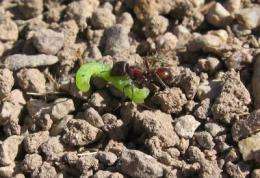In relationships based on mutuality, number of individuals involved can determine rate at which species evolve

(Phys.org)—The relationship between species determines how rapidly they evolve. Parasites and their hosts coevolve more rapidly, and partners in a mutualistic relationship can evolve more slowly. But this view is obviously too simplistic. The rate of evolution in a mutualistic relationship does not depend only on the type of interactions, but also on the number of individuals involved, according to a model developed by researchers of the Max Planck Institute for Evolutionary Biology in Plön, Germany. Therefore, while partners can benefit from slow evolution if only two individuals interact, a higher rate of evolution may be favoured if several individuals are involved.
Parasites and hosts conduct an arms race with one another in which the parasite must constantly find new ways to circumvent the defensive measures of the host. As a result, they both constantly evolve. This is similar to the situation of the Red Queen in the book "Through the Looking Glass, and What Alice Found There" by British author Lewis Carroll, and is therefore labelled the Red Queen Hypothesis. The counterpart to it is the Red King's Hypothesis, first posited in 2003: in mutualistic relationships, evolving more slowly can be favoured. This occurs, namely, when the partners behave egotistically in the beginning and then attempt to become more altruistic. The partner holding back and evolving more slowly benefits, as it does not have to invest anything in improving the partnership.
Up to now, researchers have explored the Red King Hypothesis only in models for which two individuals come into contact with one another. However, this does not reflect reality for the most part. It is much more often the case in nature that several individuals are in a relationship with one another. Thus, several ants protect a single butterfly larva in order to be rewarded with its honeydew. For the ant, the relationship is therefore between two individuals; however, from the perspective of the caterpillar, there are multiple partners interacting.
The scientists in Plön have therefore tested the Red King's Hypothesis in a multiplayer model. According to this, it was confirmed that the Red King's Hypothesis is only valid in pairwise mutualistic relationships. As soon as several parties are involved, it becomes considerably more complicated. "Then more rapid evolution can be favoured for a party as well," explains Chaitanya Gokhale from the Max Planck Institute for Evolutionary Biology.
More information: Chaitanya S. Gokhale and Arne Traulsen, Mutualism and evolutionary multiplayer games: revisiting the Red King, Proc. R. Soc. B published online 12 September 2012 (doi: 10. 1098/rspb. 2012. 1697
Provided by Max Planck Society

















